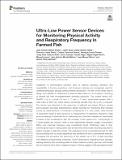Por favor, use este identificador para citar o enlazar a este item:
http://hdl.handle.net/10261/223218COMPARTIR / EXPORTAR:
 SHARE
BASE SHARE
BASE
|
|
| Visualizar otros formatos: MARC | Dublin Core | RDF | ORE | MODS | METS | DIDL | DATACITE | |

| Título: | Ultra-low power sensor devices for monitoring physical activity and respiratory frequency in farmed fish |
Autor: | Martos-Sitcha, Juan Antonio CSIC ORCID; Sosa, Javier; Ramos-Valido, Dailos; Bravo, Francisco Javier; Carmona-Duarte, Cristina; Gomes, Henrique Leonel; Calduch-Giner, Josep A. CSIC ORCID; Cabruja Casas, Enric CSIC ORCID ; Vega, Aurelio; Ferrer, Miguel Ángel; Lozano Fantoba, Manuel CSIC ORCID ; Montiel-Nelson, Juan Antonio; Afonso, Juan Manuel; Pérez-Sánchez, Jaume CSIC ORCID | Palabras clave: | Aquaculture Sensor Swimming tests Fish welfare Physical activity Respiratory frequency Oxygen consumption |
Fecha de publicación: | 2020 | Editor: | Frontiers Media | Citación: | Welfare and Stressors in Fish: Challenges Facing Aquaculture: 184-197 (2020) | Resumen: | Integration of technological solutions aims to improve accuracy, precision and repeatability in farming operations, and biosensor devices are increasingly used for understanding basic biology during livestock production. The aim of this study was to design and validate a miniaturized tri-axial accelerometer for non-invasive monitoring of farmed fish with re-programmable schedule protocols. The current device (AE-FishBIT v.1s) is a small (14 mm × 7 mm × 7 mm), stand-alone system with a total mass of 600 mg, which allows monitoring animals from 30 to 35 g onwards. The device was attached to the operculum of gilthead sea bream (Sparus aurata) and European sea bass (Dicentrarchus labrax) juveniles for monitoring their physical activity by measurements of movement accelerations in x- and y-axes, while records of operculum beats (z-axis) served as a measurement of respiratory frequency. Data post-processing of exercised fish in swimming test chambers revealed an exponential increase of fish accelerations with the increase of fish speed from 1 body-length to 4 body-lengths per second, while a close relationship between oxygen consumption (MO2) and opercular frequency was consistently found. Preliminary tests in free-swimming fish kept in rearing tanks also showed that device data recording was able to detect changes in daily fish activity. The usefulness of low computational load for data pre-processing with on-board algorithms was verified from low to submaximal exercise, increasing this procedure the autonomy of the system up to 6 h of data recording with different programmable schedules. Visual observations regarding tissue damage, feeding behavior and circulating levels of stress markers (cortisol, glucose, and lactate) did not reveal at short term a negative impact of device tagging. Reduced plasma levels of triglycerides revealed a transient inhibition of feed intake in small fish (sea bream 50–90 g, sea bass 100–200 g), but this disturbance was not detected in larger fish. All this considered together is the proof of concept that miniaturized devices are suitable for non-invasive and reliable metabolic phenotyping of farmed fish to improve their overall performance and welfare. Further work is underway for improving the attachment procedure and the full device packaging. | Versión del editor: | https://doi.org/10.3389/fphys.2019.00667 | URI: | http://hdl.handle.net/10261/223218 | DOI: | 10.3389/fphys.2019.00667 | ISBN: | 978-2-88963-625-9 |
| Aparece en las colecciones: | (IATS) Libros y partes de libros |
Ficheros en este ítem:
| Fichero | Descripción | Tamaño | Formato | |
|---|---|---|---|---|
| Ultra_low.pdf | 4,5 MB | Adobe PDF |  Visualizar/Abrir |
CORE Recommender
WEB OF SCIENCETM
Citations
9
checked on 02-dic-2021
Page view(s)
201
checked on 01-may-2024
Download(s)
162
checked on 01-may-2024
Google ScholarTM
Check
Altmetric
Altmetric
Este item está licenciado bajo una Licencia Creative Commons

